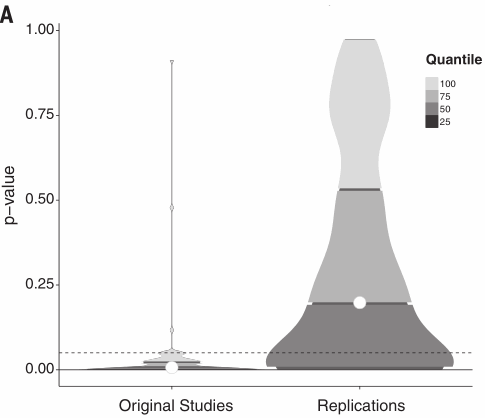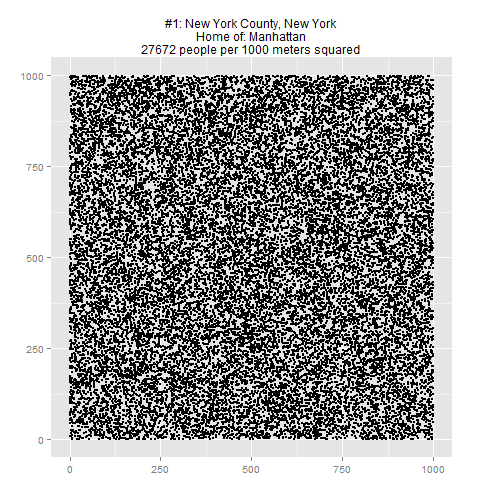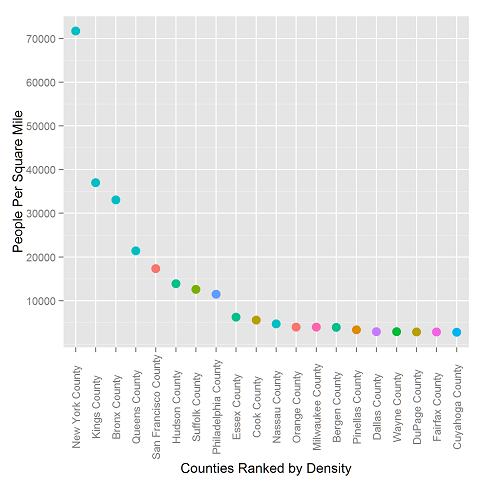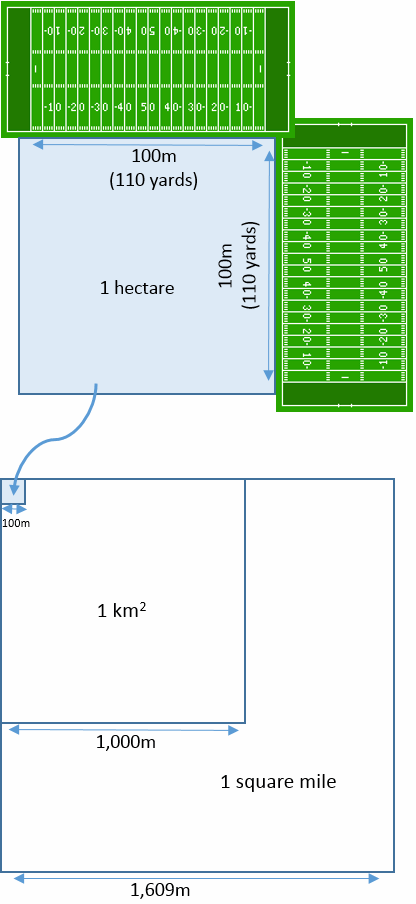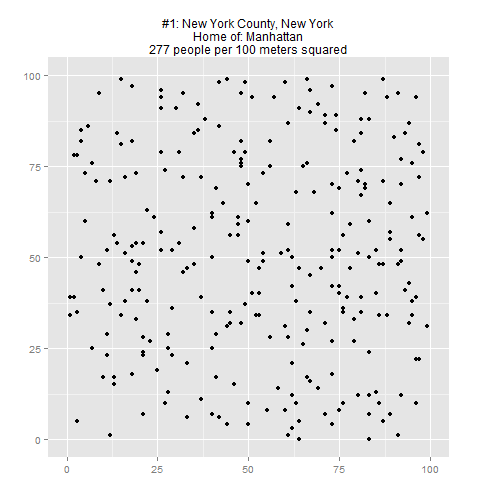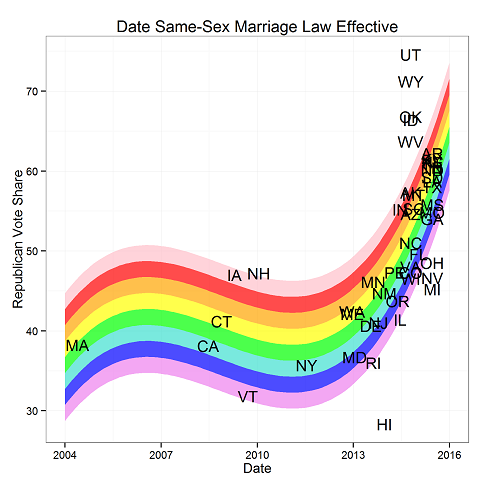Estimating the reproducibility of psychological science
 Subscribe to Decision Science News by Email (one email per week, easy unsubscribe)
Subscribe to Decision Science News by Email (one email per week, easy unsubscribe)
THE REPRODUCIBILITY IS NOT GOOD, BUT THE FIELD CAN FIX ITSELF
Science Magazine has just published the article Estimating the reproducibility of psychological science/ (PDF). We’ll let the abstract speak for itself.
ABSTRACT
Reproducibility is a defining feature of science, but the extent to which it characterizes current research is unknown. We conducted replications of 100 experimental and correlational studies published in three psychology journals using high-powered designs and original materials when available. Replication effects were half the magnitude of original effects, representing a substantial decline. Ninety-seven percent of original studies had statistically significant results. Thirty-six percent of replications had statistically significant results; 47% of original effect sizes were in the 95% confidence interval of the replication effect size; 39% of effects were subjectively rated to have replicated the original result; and if no bias in original results is assumed, combining original and replication results left 68% with statistically significant effects. Correlational tests suggest that replication success was better predicted by the strength of original evidence than by characteristics of the original and replication teams.
The work was done by the Open Science Collaboration, a group of 270 authors, led by Brian Nosek.
Now, the question on everyone’s mind. What do you think about this, Decision Science News?
- When we review papers, we see a lot of quibbling about theoretical contributions, which editors readily embrace and push back on authors. These debates are almost entirely subjective. Rarely do reviewers say “given the sample sizes here, and researcher degrees of freedom (i.e., the countless ways that authors can deceive themselves by massaging the data until desired results emerge), I don’t believe there’s anything here. I want to see this replicate on a larger sample.” And when they do, editors rarely push the authors to replicate as if it’s impolite, like it’s accusing the authors of cheating. Let’s change that. The first order concern is establishing the effect or its absence. Worry about the theory next. To do otherwise is a waste of time.
- People think this is bad news for psychology. For psychology past, sure. But for psychology future, it’s a good thing. Decision Science News has met many psych researchers in recent years who are embracing replication, favoring larger samples, and being skeptical of what they read in Psychological Science. They’ve also started researching topics like: false positive psychology, p-hacking, and researcher degrees of freedom. People seem eager to break with the past.
- Non-replication doesn’t imply shenanigans in the original study. Non-replications can happen for a lot of reasons. However, when a lot of findings don’t replicate, it’s a sign that something’s wrong. We suspect that a lot of what doesn’t replicate is the result of file-drawer effects and p-hacking.
- We probably would have seen better replication results if the original studies were larger. Large samples make it much more difficult for researchers to deceive themselves during data analysis because small adjustments (i.e., exercising “researcher degrees of freedom”) don’t change things much when samples are large.
- Fields that haven’t run their own massive replication projects shouldn’t throw stones.
MEMBERS OF THE OPEN SCIENCE COLLABORATION (APPLAUSE TO ALL)
Alexander A. Aarts, Joanna E. Anderson, Christopher J. Anderson, Peter R. Attridge,, Angela Attwood, Jordan Axt, Molly Babel, Štepán Bahník, Erica Baranski, Michael Barnett-Cowan, Elizabeth Bartmess, Jennifer Beer, Raoul Bell, Heather Bentley, Leah Beyan, Grace Binion, Denny Borsboom, Annick Bosch, Frank A. Bosco, Sara D. Bowman, Mark J. Brandt, Erin Braswell, Hilmar Brohmer, Benjamin T. Brown, Kristina Brown, Jovita Brüning,, Ann Calhoun-Sauls, Shannon P. Callahan, Elizabeth Chagnon, Jesse Chandler,, Christopher R. Chartier, Felix Cheung,, Cody D. Christopherson, Linda Cillessen, Russ Clay, Hayley Cleary, Mark D. Cloud, Michael Cohn, Johanna Cohoon, Simon Columbus, Andreas Cordes, Giulio Costantini, Leslie D. Cramblet Alvarez, Ed Cremata, Jan Crusius, Jamie DeCoster, Michelle A. DeGaetano, Nicolás Della Penna, Bobby den Bezemer, Marie K. Deserno, Olivia Devitt, Laura Dewitte, David G. Dobolyi, Geneva T. Dodson, M. Brent Donnellan, Ryan Donohue, Rebecca A. Dore, Angela Dorrough,, Anna Dreber, Michelle Dugas, Elizabeth W. Dunn, Kayleigh Easey, Sylvia Eboigbe, Casey Eggleston, Jo Embley, Sacha Epskamp, Timothy M. Errington, Vivien Estel, Frank J. Farach,, Jenelle Feather, Anna Fedor, Belén Fernández-Castilla, Susann Fiedler, James G. Field, Stanka A. Fitneva, Taru Flagan, Amanda L. Forest, Eskil Forsell, Joshua D. Foster, Michael C. Frank, Rebecca S. Frazier, Heather Fuchs, Philip Gable, Jeff Galak, Elisa Maria Galliani, Anup Gampa, Sara Garcia, Douglas Gazarian, Elizabeth Gilbert, Roger Giner-Sorolla, Andreas Glöckner,, Lars Goellner, Jin X. Goh, Rebecca Goldberg, Patrick T. Goodbourn, Shauna Gordon-McKeon, Bryan Gorges, Jessie Gorges, Justin Goss, Jesse Graham, James A. Grange, Jeremy Gray, Chris Hartgerink, Joshua Hartshorne, Fred Hasselman,, Timothy Hayes, Emma Heikensten, Felix Henninger,, John Hodsoll,, Taylor Holubar, Gea Hoogendoorn, Denise J. Humphries, Cathy O.-Y. Hung, Nathali Immelman, Vanessa C. Irsik, Georg Jahn, Frank Jäkel, Marc Jekel, Magnus Johannesson, Larissa G. Johnson, David J. Johnson, Kate M. Johnson, William J. Johnston, Kai Jonas, Jennifer A. Joy-Gaba, Heather Barry Kappes, Kim Kelso, Mallory C. Kidwell, Seung Kyung Kim, Matthew Kirkhart, Bennett Kleinberg,, Goran Kneževic, Franziska Maria Kolorz, Jolanda J. Kossakowski, Robert Wilhelm Krause, Job Krijnen, Tim Kuhlmann, Yoram K. Kunkels, Megan M. Kyc, Calvin K. Lai, Aamir Laique, Daniël Lakens, Kristin A. Lane, Bethany Lassetter, Ljiljana B. Lazarevic, Etienne P. LeBel, Key Jung Lee, Minha Lee, Kristi Lemm, Carmel A. Levitan, Melissa Lewis, Lin Lin, Stephanie Lin, Matthias Lippold, Darren Loureiro, Ilse Luteijn, Sean Mackinnon, Heather N. Mainard, Denise C. Marigold, Daniel P. Martin, Tylar Martinez, E.J. Masicampo, Josh Matacotta, Maya Mathur, Michael May,, Nicole Mechin, Pranjal Mehta, Johannes Meixner,, Alissa Melinger, Jeremy K. Miller, Mallorie Miller, Katherine Moore,, Marcus Möschl, Matt Motyl, Stephanie M. Müller, Marcus Munafo, Koen I. Neijenhuijs, Taylor Nervi, Gandalf Nicolas, Gustav Nilsonne,, Brian A. Nosek,, Michèle B. Nuijten, Catherine Olsson,, Colleen Osborne, Lutz Ostkamp, Misha Pavel, Ian S. Penton-Voak, Olivia Perna, Cyril Pernet, Marco Perugini, R. Nathan Pipitone, Michael Pitts, Franziska Plessow,, Jason M. Prenoveau, Rima-Maria Rahal,, Kate A. Ratliff, David Reinhard, Frank Renkewitz, Ashley A. Ricker, Anastasia Rigney, Andrew M. Rivers, Mark Roebke, Abraham M. Rutchick, Robert S. Ryan, Onur Sahin, Anondah Saide, Gillian M. Sandstrom, David Santos,, Rebecca Saxe, René Schlegelmilch,, Kathleen Schmidt, Sabine Scholz, Larissa Seibel, Dylan Faulkner Selterman, Samuel Shaki, William B. Simpson, H. Colleen Sinclair, Jeanine L. M. Skorinko, Agnieszka Slowik, Joel S. Snyder, Courtney Soderberg, Carina Sonnleitner, Nick Spencer, Jeffrey R. Spies, Sara Steegen, Stefan Stieger, Nina Strohminger, Gavin B. Sullivan, Thomas Talhelm, Megan Tapia, Anniek te Dorsthorst, Manuela Thomae,, Sarah L. Thomas, Pia Tio, Frits Traets, Steve Tsang, Francis Tuerlinckx, Paul Turchan, Milan Valášek, Anna E. van ‘t Veer,, Robbie Van Aert, Marcel van Assen, Riet van Bork, Mathijs van de Ven, Don van den Bergh, Marije van der Hulst, Roel van Dooren, Johnny van Doorn, Daan R. van Renswoude, Hedderik van Rijn, Wolf Vanpaemel, Alejandro Vásquez Echeverría, Melissa Vazquez, Natalia Velez, Marieke Vermue, Mark Verschoor, Michelangelo Vianello, Martin Voracek, Gina Vuu, Eric-Jan Wagenmakers, Joanneke Weerdmeester, Ashlee Welsh, Erin C. Westgate, Joeri Wissink, Michael Wood, Andy Woods,, Emily Wright, Sining Wu, Marcel Zeelenberg, Kellylynn Zuni
